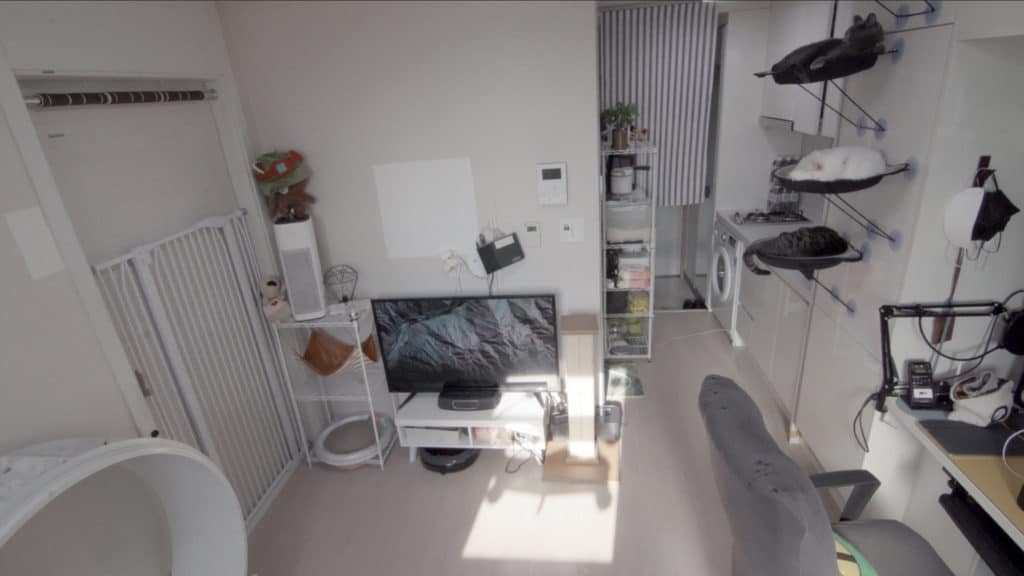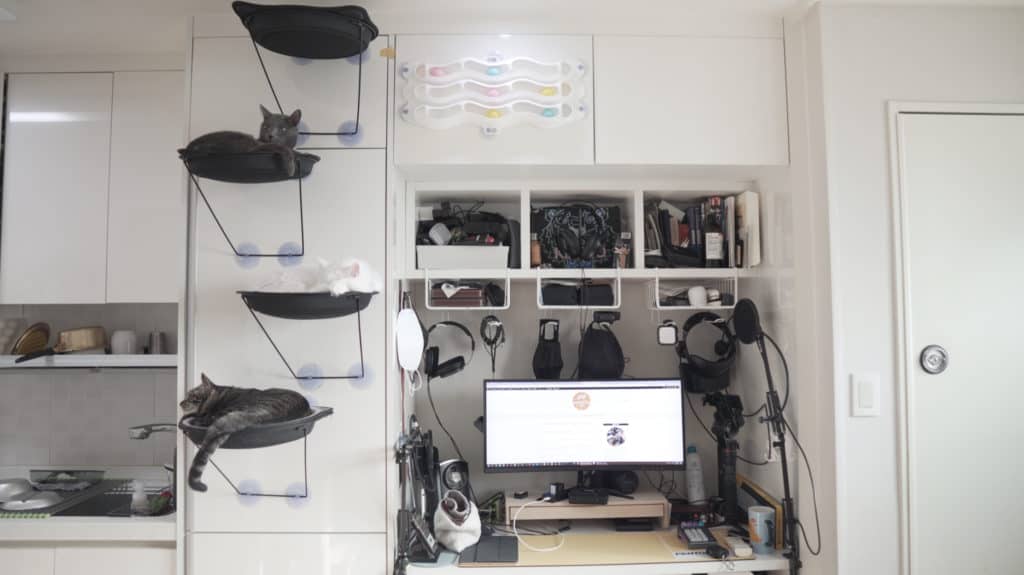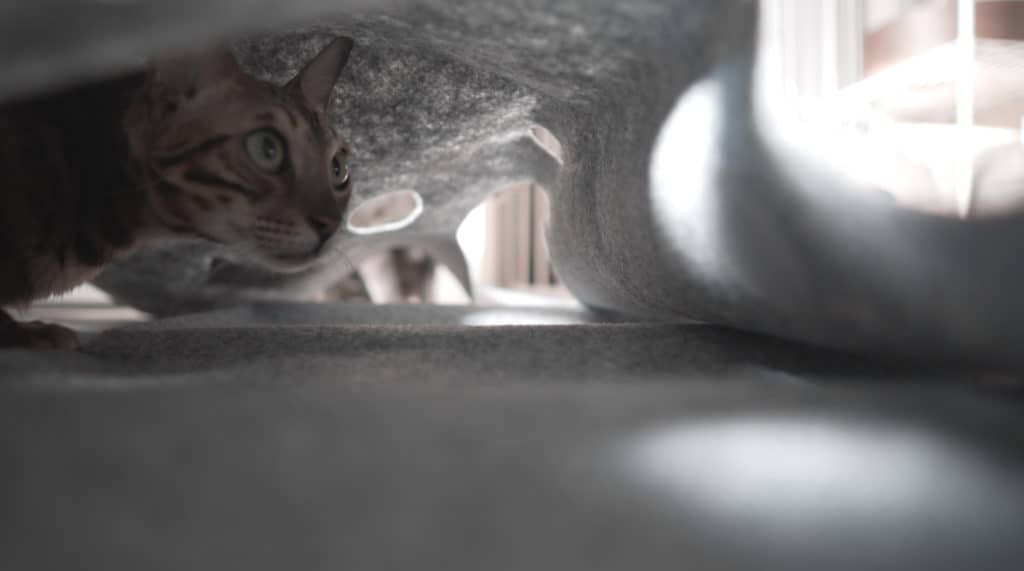I’ll be first to advocate that you can live with your cats in almost any living area or space (I live with 4 cats in a tiny apartment). However, this doesn’t mean having cats just for sake of having a cat. Cats are living creatures with their own personality, preferences, and energy levels.
Similar to us humans, just because we might be stuck indoors all the time – doesn’t mean we shouldn’t try to exercise, engage ourselves, and have healthy habits at home.
Same with our cats.

Do apartment cats get bored? Yes, cats living in apartments can get bored if there is not enough environmental stimulation to get their mind and body engaged. Having the right environment, along with a good routine for our cats – can avoid the many health and behavioral risks associated with boredom.
It doesn’t matter if we’re living in a big house, or small apartment – a home that has no thought in how cats might use the space means it’s more likely that our cats will be bored and might develop negative or unwanted traits.
Cat Boredom: Health and Behavioral Risks
Boredom can be a bigger problem than a lot of cat owners think. Aside from the obvious issues, boredom can lead our cats to lash out in ways that we might be aware of.
This is sometimes evident in high-energy cats such as Bengal cats (how does a Bengal compare to a lower energy breed such as the Russian Blue? read here!) where they are usually misunderstood to be either too aggressive or destructive but in reality, they are actually just bored.
So what are these issues and risks that might occur in bored cats?
- Overeating
- General Lethargy
- Destructive or unwanted behaviors (biting, scratching, knocking things off desks, or getting into places that they shouldn’t be).
**For those that are worried about cats scratching furniture – picking the right breed, proper catification, and boredom prevention are the best ways to protect your furniture. - Aggressive towards other people or animals in the home/apartment (i.e. nipping at ankles, swatting people or things moving past, biting hands, etc.)
- Joint problems
- Being overly vocal or constant meowing
As said before, these issues are not obvious to a lot of people and over time they can wreak havoc on our cat’s wellbeing. Therefore, being aware of our cat’s trends over time is a good skill to develop.
How to Prevent Your Cats From Getting Bored
There are many ways to help our cats engage more with their environment and just be more active within their home.
Catification of Your Apartment
This doesn’t mean to have cat towers and scratching posts all throughout the apartment. It means thinking about and designing your space in such a way that cats can navigate well throughout the home (which can really help with adjustment periods after a big change! See the chart here) and have spaces that instinctually, cats need and want.
I tell people all the time to think about how cats might use spaces outdoors and try to some parts of it inside. For example, cats can climb all sorts of objects outdoors, therefore, it’s probably a good idea to have multiple places that our cats can climb to.

Whether it’s to observe, get away from danger, or claim territory – cats just feel more confident when there’s a lot of elevated surfaces. With a lot of elevated areas – even transversing throughout the home will burn some of that tuna can off.
Now you might say to me that you have a cat tower or a cat scratcher – however, that’s just one or two options and usually, it’s put in a corner of the room. This doesn’t allow our cats to access other areas of the room, nor is it a socially important spot.
Cats want to be in the center of the action – they don’t want to be actually directly participating in it but they do want to be in the presence of it. Just to check on whatever it is their humans are doing.
For a guide on catification and how you can catify without denting your wallet visit my article: 4 Ideas For Catification on a Budget!
Routine To Prevent Boredom in Cats
A routine or schedule helps all cats better use their energy throughout the day. Being able to control when a cat plays and eats, helps them adapt to our own schedules too.
They’ll be active when their owners are active and relaxed when we are relaxed. After a time of having these routines for your cat, it keeps them looking forward to playtime and their energy levels to match with yours.

Cats eat to recoup their energy followed by a big nap. However, if their food is always available, it’s hard to predict our cat’s energy levels.
This is where scheduled meal times come into play. As we plan each time our cats eat – we know that following their nap (after the meal) is when their energy level comes back up. For more in-depth information about scheduled meal times, read here!
Using routine and schedules, we can better predict and guide our cat’s lifestyles to better fit ours.
For the most optimal times to play with your cat, read it here!
Cat Companionship to Prevent Boredom
I think by now, most of us know that cats are more social than we thought in the past. It’s been proven in scientific studies and by cat behaviorists.
Cats are just more well-rounded when they’re brought up with other cats around them as kittens. They learn a lot from each other and initiate a lot of activities themselves. How many cats do you think can live in a small apartment? The answer might surprise you!
Kittens that don’t have an outlet for this energy will tend to direct their energy towards their human or other things around the house.
That’s why it’s better to adopt 2 or more cats from the same litter, rather than one individual cat.
However, if you’re thinking about adopting or introducing another cat to your apartment with one resident cat – there’s a lot of things to consider. Age, gender, and personality are all things we have to look at.
For the full comprehensive guide on how I introduce cats without separation or isolation within my small apartment, click here!
Other Ways to Prevent Boredom in Cats
While those are the 3 main ways to prevent boredom for our cats, there is some stuff we can do in addition to the methods discussed to further enhance our cat’s engagement.
Cat Toy Cycling & Recommended Toys
The first tip is to toy cycle – cats like variety much like any other living creature. While they are usually okay with playing with the same toys most of the time, novelty also matters.

Studies show that cats are more reactive even when it’s the same toy but clean and differing only in color. Take note of what your cat’s favorite toys (usually 3-4) are and use a different one each day. Maybe even change up the smell by putting the toy in a bag of catnip.
Environmental enrichment doesn’t mean leaving a bunch of toys scattered on the floor – the toys are just sitting there. That’s why the best way to play with our cats is to have some sort of interactive toy that moves in a way much like their natural prey would.
I have curated a list of the best toys for indoor cats here: Best Toys For Indoor Cats (Minimal Clutter & Super Effective)
Effectiveness of Puzzle Feeders
Why not have your cats obtain their food naturally like they would in the outdoors? Puzzle feeders are great for turning mealtimes into a fun activity for your cats and also lets you be more involved with them when they eat too!
Since you have to put food manually into the puzzle feeder toys/items, it’s a good way to trick yourself to stay consistent at feeding your cats on a schedule.
Put their meal in a puzzle feeder and watch them paw and grab at their food. This is very effective at controlling cats that like to overeat or just simply eat too fast. This can prevent other eating issues such as vomiting.
It helps stimulate their mind and engage them during meal times. Also, slowing down the pace of eating their meals helps with weight management.
Puzzle feeders are great for lazy cat breeds such as the Scottish Fold and Ragdoll because it forces them to actually start moving to obtain their food. This small change can turn into large behavioral changes for the better!
